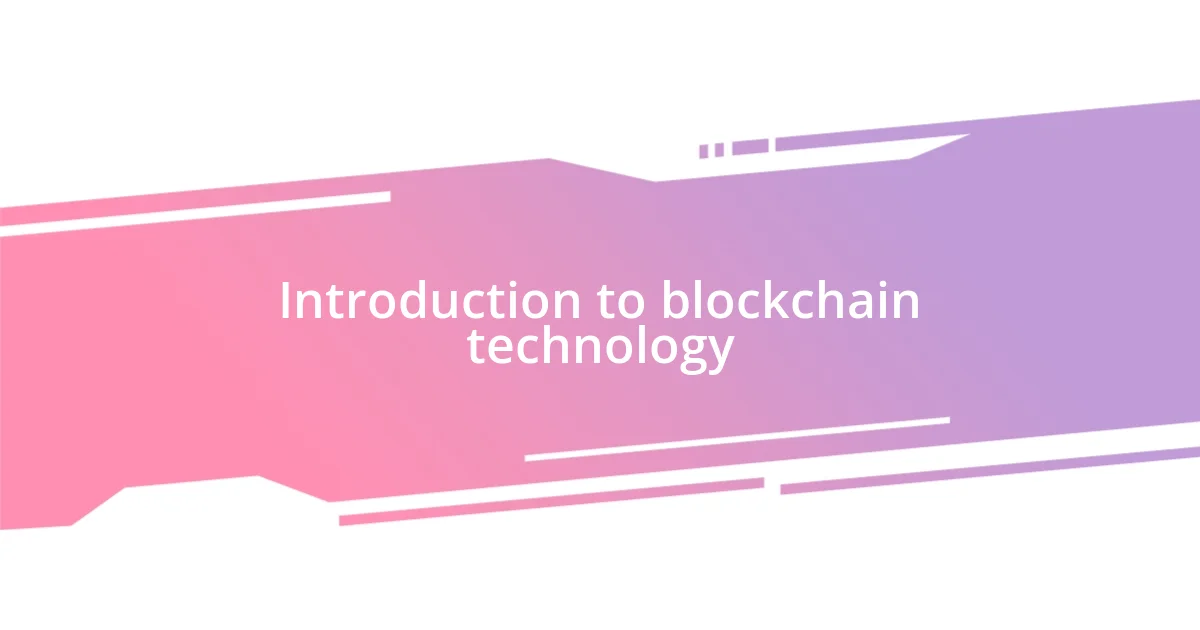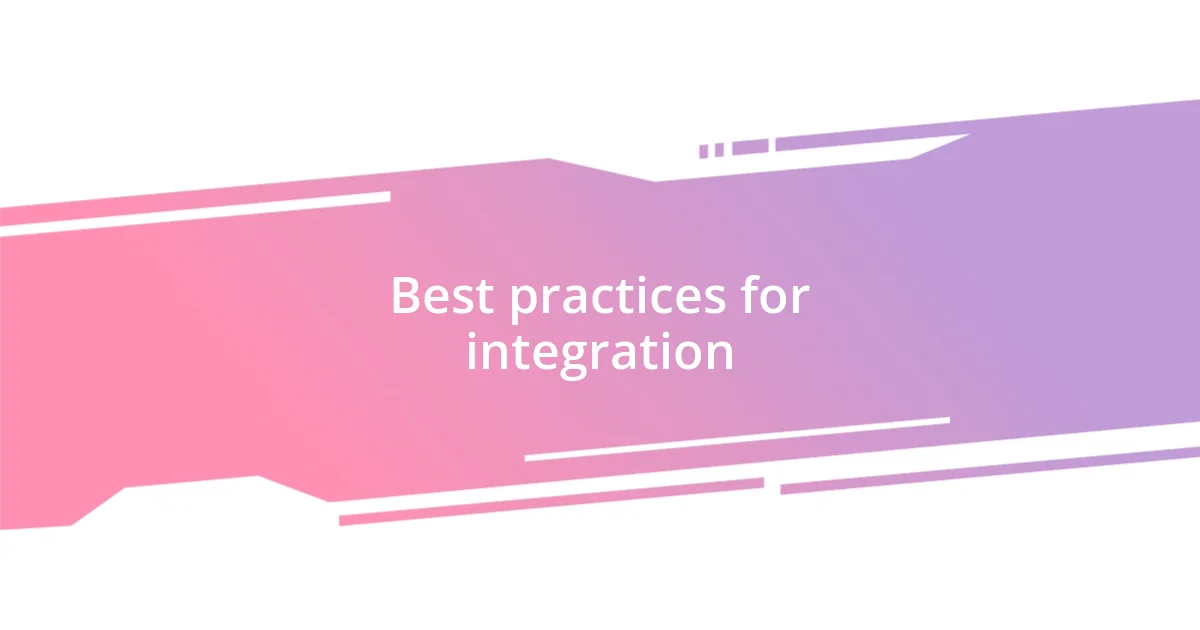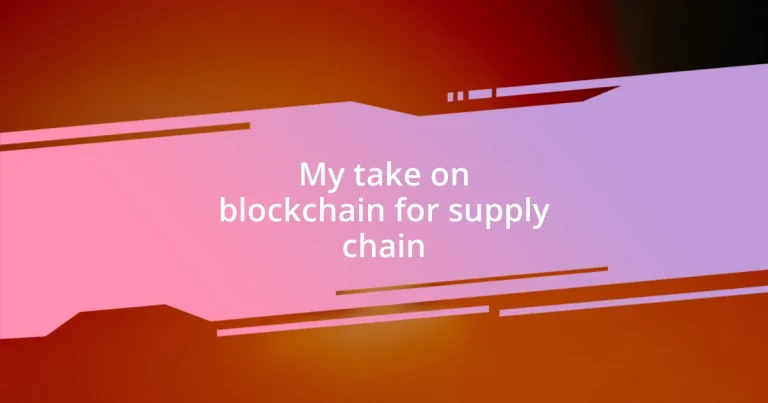Key takeaways:
- Blockchain enhances supply chain efficiency by providing transparency, traceability, and cost reduction, significantly transforming traditional processes.
- Challenges in adopting blockchain include lack of regulations, high initial investment, and security concerns, which can deter companies from integrating the technology.
- Successful integration practices involve starting with pilot projects, fostering collaboration among stakeholders, and committing to continuous education and training to navigate the evolving technology.

Introduction to blockchain technology
Blockchain technology has revolutionized the way we think about data sharing and security. Imagine a digital ledger that’s not only transparent but also immutable, making it nearly impossible to tamper with. This idea of trust without a middleman truly fascinates me – it’s like having a financial guardian that is always watching over your transactions without bias.
When I first heard about blockchain, I was skeptical about its practical applications. After diving into various case studies and understanding its mechanics, I realized that this technology offers a new level of accountability, especially in industries where trust is paramount. Have you ever faced doubts about the authenticity of a product? With blockchain, each step of a product’s journey can be traced back, ensuring that what you see is genuinely what you get.
As I explored blockchain further, I discovered how it functions through a decentralized network, which made me rethink traditional supply chain models. The idea that multiple participants can view and verify the same information simultaneously was a game-changer for me. It’s as if the entire system is woven together with threads of transparency and reliability, creating a fabric that’s resilient against errors and fraud. Isn’t it exciting to think about the potential this holds for a more efficient future?

Key benefits of blockchain implementation
The benefits of implementing blockchain in supply chain management are numerous and compelling. I’ve seen firsthand how this technology can enhance efficiency. It cuts down on paperwork and reduces delays, allowing for seamless operations. Imagine a scenario where you no longer have to chase down invoices or shipment statuses – that’s a game changer.
Here are some key benefits I’ve observed:
– Transparency and Traceability: Each transaction is recorded in a secure, tamper-proof manner, allowing all participants to verify the product’s journey.
– Increased Trust: With shared access to a single version of the truth, disputes can be minimized, leading to stronger relationships between supply chain partners.
– Cost Reduction: Automating processes and cutting out middlemen can substantially lower operational costs.
– Enhanced Security: Blockchain’s encryption makes it incredibly difficult for fraud and unauthorized access to occur, protecting sensitive information.
– Streamlined Processes: Smart contracts can automate actions based on predefined criteria, leading to faster response times and reduced manual intervention.
One of my favorite examples of blockchain’s impact is in tracking food products. I remember a time when I had concerns about the origins of a certain food item I bought. If that company had utilized blockchain, I could have scanned a code, instantly accessing its journey from farm to table. That level of transparency can really foster trust, don’t you think?

Challenges in adopting blockchain
Adopting blockchain technology in supply chains isn’t as straightforward as one might hope. One major challenge is the lack of clear regulations and standards. Without a governing body setting these guidelines, companies may hesitate to invest in blockchain solutions. This uncertainty can stall innovation and leave businesses feeling lost in a sea of possibilities.
Another obstacle is the need for significant investment in technology and training. From my experience, organizations often see the initial costs and think twice. I once worked with a company that had potential blockchain applications but couldn’t proceed due to budget constraints. It’s disheartening when a brilliant idea has to sit on the back burner because of financial hurdles.
Lastly, security concerns can be a double-edged sword. While blockchain boasts enhanced security features, any system is only as strong as its weakest link. I remember a discussion I had with a logistics manager who expressed anxiety about the potential for cyberattacks on a decentralized system. It’s a valid concern; even the most advanced technology requires vigilance to thwart malicious actors.
| Challenge | Description |
|---|---|
| Lack of Regulations | Uncertain guidelines may hinder investment and innovation in blockchain. |
| High Initial Investment | Significant costs for technology and training can deter companies from adoption. |
| Security Concerns | Risks of cyberattacks can undermine confidence in decentralized systems. |

Real-world case studies of blockchain
One fascinating case study I came across is IBM and Walmart’s collaboration on a food traceability project. They implemented blockchain to enhance supply chain transparency for leafy greens. A breakthrough moment for me was when Walmart reduced the time to trace the origin of these products from weeks to mere seconds. That’s not just impressive; it’s a lifesaver when it comes to food safety.
Another inspiring example is the diamond industry, where Everledger uses blockchain to track the provenance of diamonds. I remember reading about their efforts to ensure that gems are ethically sourced. The emotional weight of this initiative struck me; it validates the investment of customers who want to make responsible choices. Plus, knowing that blockchain can help prevent conflict diamonds from entering the market adds a layer of trust that’s invaluable.
Then there’s the project by De Beers, also aimed at the diamond market, focusing on providing buyers with proof of a diamond’s source. They’ve used blockchain to create a digital record from mine to retail. What I find compelling is how this not only offers transparency but also serves as a marketing tool. Doesn’t it feel good to know your purchase supports ethical practices? This intersection of morals and technology can truly reshape how we engage with products.

Best practices for integration
When integrating blockchain into supply chains, one of the best practices I’ve encountered is to start small with pilot projects. I recall a client who opted for a limited implementation focusing on a single product line. This approach not only minimized risk but also allowed the team to refine their processes before scaling up. How often do we hear about grand plans that stumble because they rushed into execution? Starting small can pave the way for more robust and informed decision-making down the road.
Another critical practice is fostering a culture of collaboration among stakeholders. In my experience, involving all parties—suppliers, customers, and technical teams—early in the integration process is vital. I remember facilitating a workshop where everyone shared their expectations and concerns. This open dialogue built trust and created a sense of ownership that significantly smoothed the deployment. Isn’t it fascinating how transparency can dissolve barriers and pave the way for innovation?
Lastly, continuous education and training play a key role in successful integration. Blockchain technology is evolving, and I’ve witnessed firsthand the hesitance that stems from a lack of understanding. At a previous job, we hosted monthly learning sessions on blockchain basics, and the results were remarkable. Employees felt empowered and were more open to embracing the technology. Wouldn’t you agree that knowledge is a game-changer when it comes to navigating complex systems? It’s this commitment to learning that keeps companies agile and ready to adapt.














